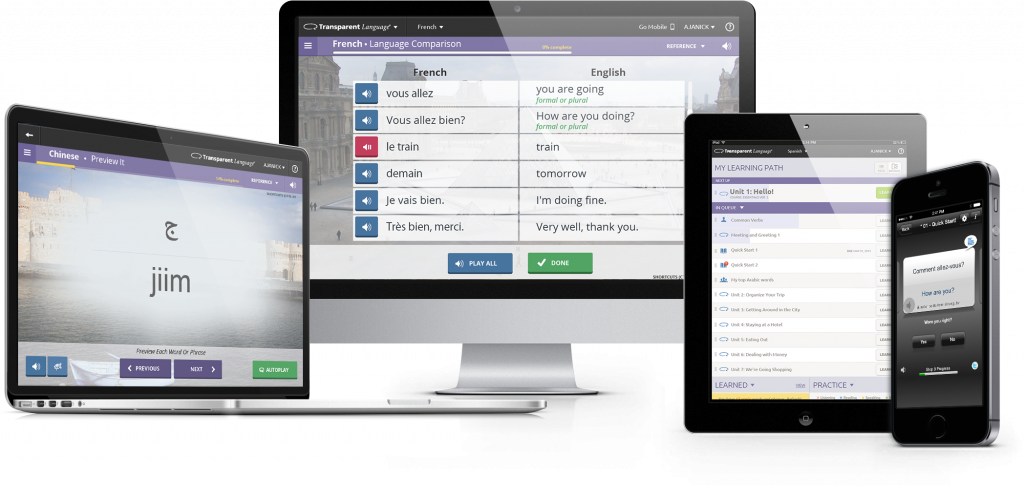When are Language-Learning Products Worth the Investment? Posted by Transparent Language on Mar 4, 2015 in Archived Posts
As a language-learning company, we at Transparent Language interact with language learners from all walks of life. Sometimes, we meet at conferences. Other times, we communicate on social media websites. Every now and then we also meet a school instructor or librarian with a passion for language learning in our daily jaunts travelling back and forth on airplanes. The question we hear most often: what’s the best way to learn a language? Since every learner is so different, there is no one-size-fits-all approach to acquiring a new language, so that question is nearly impossible to answer. Not too far behind in frequency, though, is another question: how can I learn a language for free?

In the era of the Internet of things, languages are literally at our fingertips at all times. There has been an explosion of free language-learning websites and apps in recent years, and for good reason: the world is growing smaller and language proficiency is paramount. But an industry of language-learning products and services has also established itself, also for good reason: language learning is difficult and time-consuming, and high-quality tools can both make your experience easier and keep you on track.
So when does it make sense to invest in a language-learning product?
You want professionally-developed content that is both correct and relevant. Google Translate is free, but no one uses it as their main method of learning a language. Why? Because it’s machine translation. This lends itself to inaccuracies—will it know that you mean “hard” in terms of physical durability, or will it mistakenly show you the target language word for “difficult”? Going beyond just simple translation tools, there’s a number of popular apps on the market that maintain their zero dollar price tag by crowdsourcing content—a fine idea in practice, and it allows them to grow the number of language offerings quite rapidly. But the makers behind these apps may not be language teachers or experts in the pedagogy of learning a language, leading to quirky content like “I am a penguin” or “I have the small pig on my knees.” (True story, we’ve seen both of these in other language-learning apps.) While good for a quick chuckle, these nonsensical phrases aren’t preparing you to use the language in everyday life. In this regard, it’s worth paying for correct, quality content. A curriculum designed by professionals will equip you with the grammar and vocabulary that is most relevant to your needs, unless you are, in fact, a penguin.
You want native speaker interaction and feedback—with and from a trained professional. Quality content is the golden key to unlocking and building your repository of new words and phrases, but quality delivery of those materials should not be ignored. We may be a technology company at heart, but even we recognize that nothing replaces a classroom teacher. You can find language partners on free platforms, such as Skype, but how do you know they aren’t teaching you a dialect of the language only spoken in a remote part of the world? This informal exchange is perfectly fine for some learners, especially those at more advanced levels who can successfully converse with the casual native speaker and already have a solid base of language knowledge. But if you’re at the beginning stages, you probably need guidance (and patience!) from a trained instructor – someone who knows how to help you complete your sentences with words you don’t know and works with you to pronounce new words and phrases correctly. For this type of feedback, online tutoring services with experienced instructors will provide the extra supervision and assistance that a casual exchange may lack. If you’re not up for spending money on tutoring services just yet, look for programs with native speaker audio paired with all learning materials. These recordings will help you build your listening skills and master pronunciation, allowing you to embed new vocabulary into your memory.
You need structure to stay motivated. Speaking of guidance, learning a language takes a long time (you never really finish, actually), so you’ll want a method that keeps you on track. If you’re a self-motivator who can put together lessons for yourself and keep going month after month, more power to you! But if you, like so many, need a little extra push, a guided program with structured content can make all the difference. When you don’t have to search for new learning materials and methods, you save time and precious energy. Access to an all-inclusive online program with built-in activities for expanding your vocabulary, strengthening your grammar knowledge, and building your listening, speaking, reading, and writing skills is like a one-stop-shop for language learning. Many paid programs also have multiple means for accessing content, so you can learn at home on your computer or on the go with your tablet or phone. When you don’t have WiFi access, many paid programs will still be accessible and later sync up across your devices, a big benefit that free resources lack. This flexibility is crucial to getting in the habit of learning a language—when life throws you a curve ball you can still find a time and place to get in a few minutes of exposure.
You are looking for a language-learning database for your library, school, company, or organization. Searching for a resource that meets your own needs is difficult. Finding one that meets the needs of myriad people, be they your students, employees, community members, or costumers, presents a major challenge. If you’re searching on behalf of your organization, we’ve put together a guide to help you select the right database.
Lastly, we want to leave you with one very essential piece of information: no one resource—free or paid—will teach you an entire language. Finding the right mix of resources is important. (That’s why we offer so many free resources, too!) Like we said, it’s not one-size-fits-all. Some learners may do just fine exclusively using free resources or conversing with Skype partners. But for the average learner, just starting out on their language-learning journey, the extra guidance, structure, and guaranteed quality of an online program or tutoring service may be worth it. After all, knowing another language really is priceless, right?
If you’re looking for a robust resource, but you’re not quite ready to take the plunge into paid learning, we invite you to try Transparent Language Online completely free for one week, no strings (or credit card info) attached.

Build vocabulary, practice pronunciation, and more with Transparent Language Online. Available anytime, anywhere, on any device.





Leave a comment: